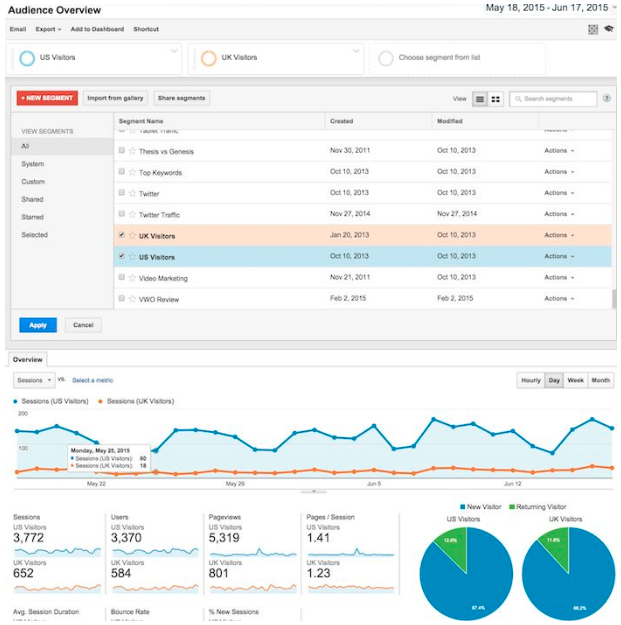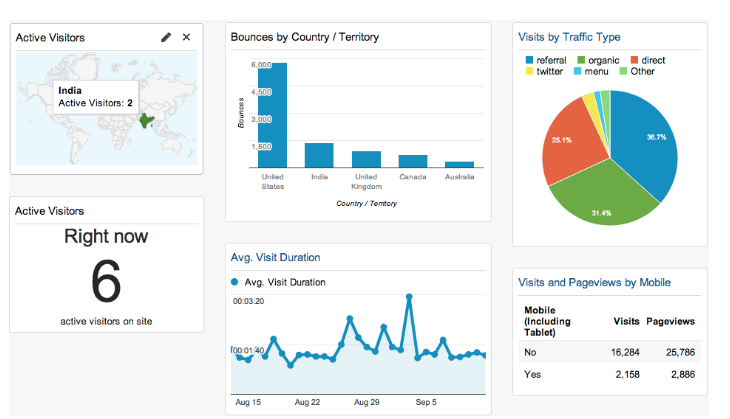By Jyotirmay Samanta
The goal of Google Analytics is to help you as a business owner to deliver a high-quality website to your customers and provide you with all the necessary information regarding the website statistics
Google analytics might seem scary at the first site. But you are an accomplished owner of a dynamic and customer-focused small business and your website represents your business! So, being inquisitive about the traffic data is your religion. As a fact, you want to know much more than just traffic data.
To give you a broader overview of what Google Analytics does, it helps businesses gain insights on their website’s traffic, where the visitors are coming from (channels, mediums, source, referrals, paid channels), which keywords draw the most traffic, what pages are visited most etc!
The data can then be drilled down to see the page views, sessions, bounce rate, new vs returning users, and session duration. Further, drill down the data to see what time of the day the users visit, what browser they visit from or what device they access your website from, the behaviour flow etc.
Google Analytics not only provides you with a lot of data, but it also pushes you in the right direction when it comes to your website optimization. You can actually get insights on whether you need to optimize the on-site SEO of your site or make your site more mobile friendly or whether to improve the website’s speed etc.
We will take a detailed look into all these in a moment and analyse how Google analytics helps business owners take important business decisions based on a huge amount of real data points. If you are a novice when it comes to Google analytics, this is the post that will push you in the right direction.
[1] Google Analytics Reports – The holy grail for understanding your website traffic
Audience Overview report :
Audience overview reports provide information on your website’s traffic at a glance. Along with that, it also provides insight into the characteristics of your users. It gives you details of your audience’s cohort, demography, age, the technology they use, behaviours and interests of your website visitors.

Image Credits – Moz
How does Audience overview report in Google Analytics help your business?
[i] As a business owner, it is paramount that you can comprehend what kind of audience your website is drawing and whether that is the customer persona you are targeting. Audience overview report pushes you in the right direction by providing clear and consistent frames of reference backed by a whole lot of data.
[ii] Once you gain insights on your customer behaviour, you can leverage it to formulate marketing strategies to increase engagement with them. It will help you target your niche audience.
[iii] Also, this helps you keep a check on how your business is doing compared to your competitors. All these extremely useful data can be used to optimize your site’s performance in order to make it more target-customer centric.
Customer Acquisition Report
This report in Google Analytics tells you from what channels and sources your website visitors landed on your website, such as search engines, social networks or referrals and what campaigns are drawing how much traffic. Acquisition report basically helps determine which marketing tactics are working and which are not.

How does Customer Acquisition report in Google Analytics help your business?
This report is an overview of your marketing tactics. This report lets you know what kind of content your audiences are enjoying and which digital marketing channels are the most successful for your business. Leverage this data to develop and optimize marketing strategies that result in higher conversions.
It can help enhance the SEO and the UI/UX of your website. If you see some pages having a high bounce rate, then divert your attention to analyze why users are abandoning those pages.
Acquisition report helps you track which sites are responsible for most referred traffic to your site and focus on developing strategies to gain more referrals from them.
Real-time Behaviour Report
With the help of real-time reports on Google Analytics, you can monitor website activity as and when it happens, i.e. in real time. You can get an overview of the no. of people that are on your site right now, which pages or events they’re interacting with, and which goal conversions have occurred. You can also continuously monitor the effects that new campaigns and site changes have on your traffic.

How Real-time reports in Google Analytics help businesses?
[i] Time-specific content marketing – With real-time data, you will get insights on when there is more number of visitors on your site; so, you can push content to your blog around that time. This will give your content a boost and increase exposure.
[ii] Also, it will give you an idea of how engaging your content is. If people are bouncing off the content too soon, you might start thinking of something else.
[3] You can also view the behaviour of your visitors with real-time analytics. This will help you get details about what is working and what’s not. Say your visitors land on your “Contact us” page but bounce before filling the form. Here you know that you will need some alterations to keep visitors engaged.
Point to remember: In order to take better decisions, make sure you avoid inflating your own website traffic. This can be done by filtering out your own IP Address.
Moving to a little more advanced Google Analytics level :
[2] Segmentation with Google Analytics :
Segmentation is a way for businesses to understand the behaviour of various groups of users (segments) on your website. It shows data based on certain criteria and tells you how different group of people (segments) interact with your website, such as all data for visitors from the United States. It also compares the performance of that segment to the performance of the whole site.

How Segmentation in Google Analytics helps Small businesses?
[i] As data is found in abundance in Google when businesses start out, they might have trouble coming to a conclusion with all that data. Segmentation converts quantitative data to qualitative data with respect to your specific business requirements, making it easier for small businesses to interpret and analyse the data.
[ii] Small business owners can segment traffic by date and time, traffic channel, geographical region etc.. You can also create custom segments to measure various sales funnel benchmarks like reaching CTA button, adding products to cart, reading your blog etc.
[iii] Segmenting website visitors in groups and targeting campaigns w.r.t each group and comparing one segment to another – really helps to derive various insights in the interest of your business. Analyse them and use them to drive campaign success as well as conversion.
[3] Setting up Goals in Google Analytics
Goals are basically created so that Google Analytics can let you know when something important has happened on your website. Goals in Google Analytics allow you to track specific user interactions on your site.

How Goals in Google Analytics Helps Your Business
[i] Businesses can set goals to keep track of specific URLs. Whenever that particular URL is visited, the goal will be triggered. Say thank you pages or order confirmation pages. This will help you know the number of completions within a specific period of time.
[ii] Businesses can set goals to track the no of users that spent a certain amount of time on your site. Also, track the no. of users that don’t spend that time on your site. This way you can track both customer engagement and also how fast your customer service provides support.
[iii] Set up goals to see the number of pages each visitor sees before they quit the website. This is also used to measure engagement. This is of help for eCommerce businesses who might want to analyse the actual users who are looking to buy.
[iv] Google Analytics also lets you set up goals when users take some specific action on your website like plays a video, shares some piece of content etc. For businesses that have a unique content strategy like video, marketing can totally use this method for their advantage.
[4] Customized Reports and Google Analytics
Google analytics has too much data, but only a portion of it is used to draw meaningful conclusions and help you optimize and make better business decisions. The reports that Google Analytics provides are okay for surface level data and offer a glimpse of what’s actually going on. Also, sorting through all that data manually is time-consuming. What custom reports do is, it collect all the data and presents them in a format that is easier to analyse.

How Does the Custom Report in Google Analytics Help Businesses?
[i] All businesses have unique strategies and thus they need specific data and more importantly, customizable analytics. With custom reports, businesses can drill down into fine details and discover correlations you wouldn’t see otherwise.
[ii] Custom reporting dashboard provides a consolidated all in one view that can be digested easily and is simpler to share and export. Also, there is provision for the dashboard to be emailed to you as a pdf either daily or weekly.
[5] Setting Custom Alerts in Google Analytics
It so happens that sometimes there is a huge dip in the web traffic or a huge drop in conversions. Manually attempting to track these fluctuations would mean keeping your eyes glued on Google Analytics 24/7. Well, you have better things to do. But again, keeping a tab of the critical fluctuations is important. Lucky for both you and me, Google Analytics came up with custom alerts to help track these variations for your website. Create custom alerts for data that are most significant and meaningful for your business and Google Analytics sends a custom notification if a change triggers one of your custom alerts. Also, you can create annotations about an alert so that you can come back as and when required to see why that alert occurred.

How Does Custom Alert in Google Analytics Help Businesses?
Stay on top of your website performance and react accordingly and make necessary changes when notified. Traffic spikes after a new campaign can indicate that the campaign is performing as expected.
[6] PPC Campaign and Which Channel Converts the Most Customers
Anyone using PPC advertisements knows that it is a key revenue driver for their businesses but also know how expensive it can get! Integrate your AdWords account with your Google Analytics and carry out a PPC audit in Google Analytics to ensure all clicks are reported accurately in Google Analytics. This will help make informed decisions.

How Tracking PPC Campaigns in Google Analytics Help Small Businesses?
[i] Adwords already show you which keywords and ads initiate the maximum conversion. Google analytics, in addition to that, will show you the customer journey, so, you’ll get an idea of what factors on your website influence the conversion rate.
[ii] With Google Analytics, you also get additional data like bounce rate, Pages Per Visit, repeat customers etc to optimize your AdWords Campaigns and make more informed business decisions.
-:: Parting words::-
The goal of Google Analytics is to help you as a business owner to deliver a high-quality website to your customers and provide you with all the necessary information regarding the website statistics. So, they let you know who’s visiting your site, who are converting and who’s not interested. Along with these which location they hail from and what social or referral channels bought them here. It also lets you set up goals and segregate your traffic. Then it helps to present all these data in an all-in-one view dashboard so that analysing all that data and taking suitable actions becomes easier for you. So, Google Analytics basically helps you market to the right people, in the right way and at the right time.
Feature Image credit: Shutterstock
CEO of Binaryfolks Pvt. Ltd.



